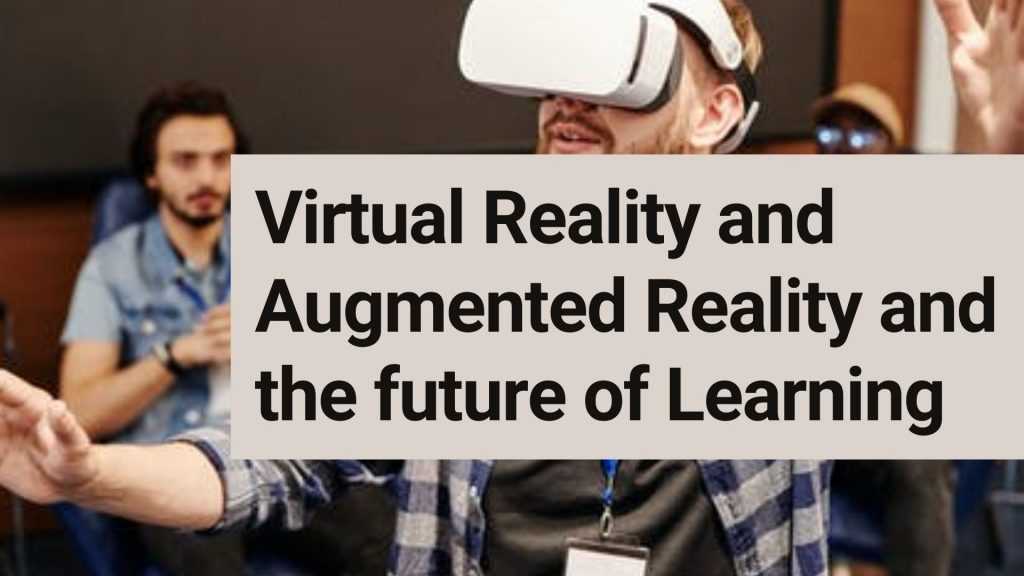AR and VR are realistic technologies that either complement or replace a real-life world with a simulated one. Augmented reality (AR) improves your surroundings by superimposing digital elements on top of a live view, most frequently utilizing the camera on a smartphone. What kind of technologies are we looking for? How much will it cost you? Is it possible to learn in virtual reality? How do we design learning programs that are compatible with this technology? To fully employ virtual reality tools, how much training is required? What types of business training are virtual reality best suited for? Virtual Reality and Augmented Reality
A virtual reality setting, such as a space, a lawn tennis court, or a conflict zone, is a computer-generated 3-D world. It generates a whole different ambiance for the users by changing things, blotting out the physical world. Consider a history class in which you are sent back in time to witness all of the events that have transpired. Every year augmented reality’s importance in our lives grows. While large corporations and start-ups develop new ways to use augmented reality in business operations, app stores continue to release more and more interesting AR apps. Education is one sector where AR has the potential to disrupt the industry.
In augmented reality, we add objects, sounds, photographs, or text to superimpose information or modify the existing scenario/real-world. Augmented reality uses the device’s camera to add various digital elements to the current user view.

What is Augmented Reality?
The term “virtual reality” refers to a three-dimensional computer-generate environment that may be examine and interact with (VR). AR, on the other hand, is a better version of reality in which live direct or indirect views of physical real-world environments are overlaid with computer-generated graphics, enhancing the user’s current perception of reality. A virtual environment is constructed in augmented reality (AR) to coexist with the real world, to be educational, and to provide more data about the real world that a user can access without having to search for it. When a phone is pointed at a piece of broken machinery, for example.
The most important educational trend is augmented reality, which is currently leading. AR in education is changing traditional classrooms in a variety of ways, from making it easier for students to get materials to teaching them how to work together. To achieve this and add value to the educational experience, schools are developing programs and using resources such as AR-enabled workbooks, virtual maps, 3D coloring books, and other tools. New learning settings emerge as a result of VR, and courses can be developed to teach learners how to work in dangerous or high-risk environments, handle hazardous chemicals, or perform other complex activities.

Benefits of Augmented Reality:
In the near future, augmented reality will completely transform the way we do business. The main benefit for businesses in developing augmented reality apps for smartphones and tablets is that the hardware is already in place, and the interface is simple to use. Users will be able to try on items without actually wearing them in the next years, as well as verify if furniture fits the interior. All of this is possible thanks to an augmented reality app for Android or iPhone. Furthermore, as technology advances, other human sensors such as smelling, touching, and feeling will become available.
Retail
Creating an augmented reality Android app or an iOS app opens up new possibilities for both offline and online purchasing. Users will be able to choose the correct size and purchase returns will be reduce thanks to virtual fitting rooms. Choosing a new automobile colour or new furniture for your apartment raises the same issues. Also, keep in mind that you can leverage this technology for promotional campaigns by including augmented reality in supporting materials.
Manufacturing
AR can help to simplify and speed up the manufacturing process. AR markings on equipment allow project managers to keep track of job progress in real time. Furthermore, using digital maps and plants can save a significant amount of time. The placement of a device demonstrates how a machine component will fit into the final structure.
Training and education
In education, augmented reality opens up truly limitless opportunities for teaching and learning. With realistic real-life simulations, additional reality offers a novel cognition path. Technology allows for a completely realistic psychological and physical experience, as well as the creation of an authentic virtual experience that can be in use in real life. Medical students can now practice their first procedures without endangering patients, while future astronauts can prepare for the next voyage into space.
Tourism and Travel
AR-enabled GPS mobile apps can display tourist routes and directions to desired destinations, translate street signs, and provide information about local attractions. Adding an extra layer of reality to museums ensures that visitors have a unique cultural experience. So, if you’re making a GPS navigation app, consider including an augmented reality component, which could give you a competitive edge.
Content
Most users are unlikely to have the expertise or capability to create a complex video like those created with augmented reality. As a result, AR enables users to create high-quality material that they otherwise would not be able to create.
Entertaining
Aside from providing high-quality information, augmented reality also produces amusing and fun content. Sharing such content with other users adds an element of surprise, making it extremely engaging. It actually encourages people to create their own versions and then share them.
Personalization is improving:
Uploading customized material to a computer facilitates the creation of highly tailored media pieces for all users. This is due to the fact that whatever is develop will be specific to the user who created it. Because of this, augmented reality is significantly more enticing than a standard image or video. However, augmented reality has a disadvantage for young people and their capacity to distinguish between fact and fantasy. Because they normalize violence, 3D augment reality games with violence are thought to increase teen hostility.
Augmented reality in E-Learning:

Eighty percent of young people now own smartphones. They are mostly smartphone users who use their gadgets to visit social media sites, play games, and communicate with friends and family. Meanwhile, a much smaller proportion of young adults use their phones for studying, homework, research, and other activities. AR and VR could be game-changer in a variety of fields, including education. A multitude of subjects and topics can be explain more effectively with this technology. They can provide children a more vivid sense of vision, making studying more engaging for all students.
Traditional educational systems have employed the same learning paradigms for decades. Teachers today do the same thing they did a century ago: they stand in front of their students. Education is one of the few fields of work in the twenty-first century that has stayed relatively constant. Virtual reality allows students to interact directly with the learning content. This increases participation as well as the desire to study. This technology has the potential to appeal to a wide range of students.
The classroom environment, including the walls and whiteboards. Is transform into gesture-controll knowledge surfaces on which teachers can show various sorts of multimedia content, such as photographs and videos, to their students via interactive AR. Teaching and learning become more dynamic with the use of augmented reality, which allows teachers to be more active in the process. Students enjoy seeing 2D images converted into 3D interactive models on computer displays. Teachers, on the other hand, benefit from a high level of student immersion. Because they have control over the equipment in a flipped classroom, they can teach as they want.
Disadvantages of Augmented Reality:
Virtual reality, according to studies, may be use to engage students who previously lack trust in a school or were unable to become interested by making studying more enjoyable. This is beneficial since emotional incentives are a great motivator for youngsters, encouraging them to work even harder in their studies.
Is it, however, safe for students to obtain instruction through augmented or virtual reality? One of the disadvantages of augmented reality is that it requires the gathering, analysis, and redistribution of a large amount of data, especially through the use of Big Data, which raises privacy and security concerns.
Augmented reality blurs the line between the real world and the digital world. As a result, another disadvantage or drawback of augmented reality is the possibility for reality alteration to cause harm. The dangers of reality shifts necessitate the creation of standards. Developers should steer clear of including too many digital elements into their AR systems.
Conclusion: Virtual Reality and Augmented Reality
Augmented reality in education makes teaching surfaces smarter. Allowing digital devices to collect and give a lot of relevant data that can be use to improve student’s learning experiences and has a big impact on the entire ecosystem. It defies expectations by offering a pleasant and engaging way to learn and understand things. Drawbacks may be a tackling point for technology to consider, and by employing pertinent information and updates. VR and AR can be improve. Because of the advantages of augmented reality, an increasing number of educational institutions are adopting it into their classrooms by converting regular walls, chalkboards, and whiteboards into AR surfaces in order to improve learning and teaching.
See also What are the most popular Google APIs?







